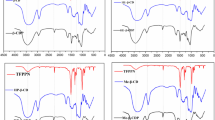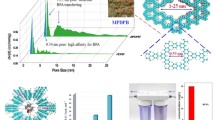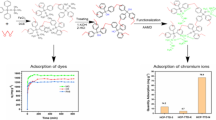Abstract
In this work, polymers containing a large number of benzene rings and multiple functional groups were designed to remove aromatic organic pollutants. Using tetrafluoroterephthalonitrile (TFTPN) as a rigid crosslinking agent to crosslink different functionalized phenylcarbamoylated-β-cyclodextrin derivatives to prepare a series of porous multifunctional cyclodextrin (CD) polymerizations, including three preliminary polymerized adsorption materials and a mix β-cyclodextrin polymer (X-CDP) prepared via a secondary crosslinking procedure of the above three materials. The X-CDP preparation process connects the pre-formed nanoparticles and increases the presence of linkers inside the particles. At the same time, X-CDP exhibited porous structure with various functional groups such as nitro, chlorine, fluorine, and hydroxyl. Those special characteristics render this material with good adsorption ability towards various aromatic organic pollutants in water, including tetracycline, ibuprofen, dichlorophenol, norfloxacin, bisphenol A, and naphthol. Especially, the maximum adsorption capacity for tetracycline at equilibrium reached 110.56 mg·g−1, which is competitive with the adsorption capacities of other polysaccharide adsorbents. X-CDP removed organic contaminants much more quickly than other adsorbents, reaching almost ~95% of its equilibrium in only 30 s, and the rate constant reaches 2.32 g·mg−1·min−1. The main adsorption process of the pollutants by X-CDP fitted the pseudo-second-order kinetic and Langmuir isotherm well, indicating that the adsorption process is monolayer adsorption. Moreover, X-CDP possessed the good reusability where the pollutant removal rate was only reduced 8.3% after five cycles. Such advantages render the polymer great potential in the rapid treatment of organic pollutants in water bodies.









Similar content being viewed by others
Data availability
The data used in this research are available by the corresponding author upon reasonable request.
References
Alsbaiee A, Smith BJ, Xiao LL, Ling YH, Helbling DE, Dichtel WR (2016) Rapid removal of organic micropollutants from water by a porous beta-cyclodextrin polymer. Nature 529(7585):190–U146. https://doi.org/10.1038/nature16185
Alvarez-Torrellas S, Rodriguez A, Ovejero G, Garcia J (2016) Comparative adsorption performance of ibuprofen and tetracycline from aqueous solution by carbonaceous materials. Chem Eng J 283:936–947. https://doi.org/10.1016/j.cej.2015.08.023
Awad AM, Shaikh SMR, Jalab R, Gulied MH, Nasser MS, Benamor A, Adham S (2019) Adsorption of organic pollutants by natural and modified clays: a comprehensive review. Sep Purif Technol 228:115719. https://doi.org/10.1016/j.seppur.2019.115719
Crini G (2021)Cyclodextrin-epichlorohydrin polymers synthesis, characterization and applications to wastewater treatment: a review. Environ Chem Lett 19(3):2383–2403. https://doi.org/10.1007/s10311-021-01204-z
Dai YJ, Zhang NX, Xing CM, Cui QX, Sun QY (2019) The adsorption, regeneration and engineering applications of biochar for removal organic pollutants: a review. Chemosphere 223:12–27. https://doi.org/10.1016/j.chemosphere.2019.01.161
Dang C, Jiranek V, Taylor DK, Wilkinson KL (2020) Removal of volatile phenols from wine using crosslinked cyclodextrin polymers. Molecules 25(4):910. https://doi.org/10.3390/molecules25040910
de Lima HHC, Llop MEG, Maniezzo RD, Moises MP, Janeiro V, Arroyo PA, Guilherme MR, Rinaldi AW (2021) Enhanced removal of bisphenol A using pine-fruit shell-derived hydrochars: adsorption mechanisms and reusability. J Hazard Mater 416:126167. https://doi.org/10.1016/j.jhazmat.2021.126167
Essandoh M, Kunwar B, Pittman CU, Mohan D, Mlsna T (2015) Sorptive removal of salicylic acid and ibuprofen from aqueous solutions using pine wood fast pyrolysis biochar. Chem Eng J 365:219–227. https://doi.org/10.1016/j.cej.2014.12.006
Fang X, Wu SB, Wu YH, Yang W, Li YL, He JH, Hong PD, Nie MX, Chao X, Wu ZJ, Zhang KS, Kong LT, Liu JH (2020)High-efficiency adsorption of norfloxacin using octahedral UIO-66-NH2 nanomaterials: dynamics, thermodynamics, and mechanisms. Appl Surf Sci 518:146226. https://doi.org/10.1016/j.apsusc.2020.146226
Guo ZP, Yang FJ, Yang RG, Sun L, Li Y, Xu JZ (2021) Preparation of novel ZnO-NP@Zn-MOF-74 composites for simultaneous removal of copper and tetracycline from aqueous solution. Sep Purif Technol 274:118949. https://doi.org/10.1016/j.seppur.2021.118949
Huang LH, Sun YY, Wang WL, Yue QY, Yang T (2011) Comparative study on characterization of activated carbons prepared by microwave and conventional heating methods and application in removal of oxytetracycline (OTC). Chemical Engineering Journal 171(3):1446–1453. https://doi.org/10.1016/j.cej.2011.05.041
Jang HM, Yoo S, Choi YK, Park S, Kan E (2018) Adsorption isotherm, kinetic modeling and mechanism of tetracycline on Pinus taeda-derived activated biochar. Bioresource Technol 259:24–31. https://doi.org/10.1016/j.biortech.2018.03.013
Jones I, Zhu MM, Zhang J, Zhang ZZ, Preciado-Hernandez J, Gao J, Zhang DK (2021) The application of spent tyre activated carbons as low-cost environmental pollution adsorbents: a technical review. J Clean Prod 312:127566. https://doi.org/10.1016/j.jclepro.2021.127566
Kanaujiya DK, Paul T, Sinharoy A, Pakshirajan K (2019) Biological treatment processes for the removal of organic micropollutants from wastewater: a review. Curr Pollut Rep 5(3):112–128. https://doi.org/10.1007/s40726-019-00110-x
Kiejza D, Kotowska U, Polinska W, Karpinska J (2021) Peracids - new oxidants in advanced oxidation processes: the use of peracetic acid, peroxymonosulfate, and persulfate salts in the removal of organic micropollutants of emerging concern - a review. Sci Total Environ 790:148195. https://doi.org/10.1016/j.scitotenv.2021.148195
Kong Y, Wang L, Ge YY, Su HY, Li ZL (2019) Lignin xanthate resin-bentonite clay composite as a highly effective and low-cost adsorbent for the removal of doxycycline hydrochloride antibiotic and mercury ions in water. J Hazard Mater 368:33–41. https://doi.org/10.1016/j.jhazmat.2019.01.026
Li L, Wang S, Zhang Y, Han R, Wei W (2017) Enhanced tetracycline adsorption onto hydroxyapatite by Fe (III) incorporation. J Mol Liq 247:171–181. https://doi.org/10.1016/j.molliq.2017.09.110
Li XX, Li J, Kang Q, Wang Y (2018) Polarity tuned perphenylcarbamoylated cyclodextrin separation materials for achiral and chiral differentiation. Talanta 185:328–334. https://doi.org/10.1016/j.talanta.2018.03.065
Liang H, Zou CJ (2019) Adsorption of naphthenic acids from oil sand process-affected water with water-insoluble poly(beta-cyclodextrin-citric acid). Can J Chem Eng 97(6):1894–1902. https://doi.org/10.1002/cjce.23452
Najafi H, Farajfaed S, Zolgharnian S, Mirak SHM, Asasian-Kolur N, Sharifian S (2021) A comprehensive study on modified-pillared clays as an adsorbent in wastewater treatment processes. Process Saf Environ 147:8–36. https://doi.org/10.1016/j.psep.2021.09.028
Ouyang JB, Zhou LM, Liu ZR, Heng JYY, Chen WQ (2020)Biomass-derived activated carbons for the removal of pharmaceutical micropollutants from wastewater: a review. Sep Purif Technol 253:117536. https://doi.org/10.1016/j.seppur.2020.117536
Patra BR, Mukherjee A, Nanda S, Dalai AK (2021) Biochar production, activation and adsorptive applications: a review. Environ Chem Lett 19(3):2237–2259. https://doi.org/10.1007/s10311-020-01165-9
Qachach H, Abriak N, El Mahrad B, Souabi S, Tahiri M (2021) Biological treatment of fuel wastewater generated from a thermal power plant by continuous and discontinuous aeration. Desalin Water Treat 222:145–155. https://doi.org/10.5004/dwt.2021.27120
Ren WJ, Gao JK, Lei C, Xie YB, Cai YR, Ni QQ, Yao JM (2018) Recyclable metal-organicframework/cellulose aerogels for activating peroxymonosulfate to degrade organic pollutants. Chem Eng J 349:766–774. https://doi.org/10.1016/j.cej.2018.05.143
Ren RY, Yang LH, Han JL, Cheng HY, Ajibade FO, Guadie A, Wang HC, Liu B, Wang AJ (2020) Perylene pigment wastewater treatment by fenton-enhanced biological process. Environ Res 186:109522. https://doi.org/10.1016/j.envres.2020.109522
Saghir S, Xiao ZG (2021) Facile preparation of metal-organic frameworks-8 (ZIF-8) and its simultaneous adsorption of tetracycline (TC) and minocycline (MC) from aqueous solutions. Mater Res Bull 141:111372. https://doi.org/10.1016/j.materresbull.2021.111372
Shah J, Jan MR, Zeeshan M, Iqbal M (2016) Solid phase extraction and removal of 2,4-dichlorophenol from aqueous samples using magnetic graphene nanocomposite. Sep Sci Technol 51(9):1480–1489. https://doi.org/10.1016/j.materresbull.2021.111372
Shirazi EK, Metzger JW, Fischer K, Hassani AH (2020) Removal of textile dyes from single and binary component systems by Persian bentonite and a mixed adsorbent of bentonite/charred dolomite. Colloid Surface A 598:124807. https://doi.org/10.1016/j.colsurfa.2020.124807
Somsesta N, Sricharoenchaikul V, Aht-Ong D (2020) Adsorption removal of methylene blue onto activated carbon/cellulose biocomposite films: equilibrium and kinetic studies. Mater Chem Phys 240:122221. https://doi.org/10.1016/j.matchemphys.2019.122221
Thaveemas P, Chuenchom L, Kaowphong S, Techasakul S, Saparpakorn P, Dechtrirat D (2021) Magnetic carbon nanofiber composite adsorbent through green in-situ conversion of bacterial cellulose for highly efficient removal of bisphenol A. Bioresource Technol 333:125184. https://doi.org/10.1016/j.biortech.2021.125184
Ushani U, Lu XQ, Wang JH, Zhang ZY, Dai JJ, Tan YJ, Wang SS, Li WJ, Niu CX, Cai T, Wang N, Zhen GY (2020) Sulfate radicals-based advanced oxidation technology in various environmental remediation: a state-of-the-art review. Chem Eng J 402:126232. https://doi.org/10.1016/j.cej.2020.126232
Wang D (2019) A critical review of cellulose-based nanomaterials for water purification in industrial processes. Cellulose 26(2):687–701. https://doi.org/10.1007/s10570-018-2143-2
Wang JH, Lei SL, Liang LQ (2020) Preparation of porous activated carbon from semi-coke by high temperature activation with KOH for the high-efficiency adsorption of aqueous tetracycline. Appl Surf Sci 530:147187. https://doi.org/10.1016/j.apsusc.2020.147187
Wang ZK, Muhammad Y, Tang R, Lu CM, Yu SS, Song RR, Tong ZF, Han BA, Zhang HB (2021a) Dually organic modified bentonite with enhanced adsorption and desorption of tetracycline and ciprofloxacin. Sep Purif Technol 274:119059. https://doi.org/10.1016/j.seppur.2021.119059
Wang ZB, Ren DJ, Yu HY, Jiang S, Cheng YH, Zhang SQ, Zhang XQ (2021b) Adsorption kinetic and isothermal studies of 2,4-dichlorophenol from aqueous solutions with zeolitic imidazolate framework-8 (ZIF-8). Environ Eng Sci 38(6):537–546. https://doi.org/10.1089/ees.2020.0286
Xiang W, Wan YS, Zhang XY, Tan ZZ, Xia TT, Zheng YL, Gao B (2020) Adsorption of tetracycline hydrochloride onto ball-milled biochar: governing factors and mechanisms. Chemosphere 255:127057. https://doi.org/10.1016/j.chemosphere.2020.127057
Yan XL, Hu XY, Chen T, Zhang SY, Zhou M (2017) Adsorptive removal of 1-naphthol from water with zeolitic imidazolate framework-67. J Phys Chem Solids 107:50–54. https://doi.org/10.1016/j.jpcs.2017.03.024
Yang WB, Lu YP, Zheng FF, Xue XX, Li N, Liu DM (2012) Adsorption behavior and mechanisms of norfloxacin onto porous resins and carbon nanotube. Chem Eng J 179:112–118. https://doi.org/10.1016/j.cej.2011.10.068
Yuan DL, Yang K, Pan SY, Xiang Y, Tang SF, Huang LT, Sun MT, Zhang XY, Jiao TF, Zhang QR (2021) Peracetic acid enhanced electrochemical advanced oxidation for organic pollutant elimination. Sep Purif Technol 276:119317. https://doi.org/10.1016/j.seppur.2021.119317
Zuo LM, Yu SM, Cheng LL, Du EL (2013) Adsorption of phenol and 1-naphthol onto XC-72 carbon. Korean J Chem Eng 30(3):714–723. https://doi.org/10.1007/s11814-012-0194-x
Funding
This work was financially funded by the National Natural Science Foundation of China (No. 21922409) and Tianjin Research Program of Application Foundation and Advanced Technology (17JCYBJC20500).
Author information
Authors and Affiliations
Contributions
Yong Wang received support from the funding. Yong Wang and Xiaofei Ma conceived and designed the study. The participation of He Wang and Congzhi Liu includes data collection and analyzing the results. Congzhi Liu, He Wang, Xiaofei Ma, and Yong Wang interpreted and wrote the manuscript.
Corresponding authors
Ethics declarations
The authors confirm that this article is original research and has not been published or presented previously in any journal or conference in any language (in whole or in part).
Consent to participate
Not applicable.
Consent for publication
Not applicable.
Competing interests
The authors declare no competing interests.
Additional information
Responsible Editor: Angeles Blanco
Publisher’s note
Springer Nature remains neutral with regard to jurisdictional claims in published maps and institutional affiliations.
Supplementary information
ESM 1
(DOCX 700 kb)
Rights and permissions
About this article
Cite this article
Wang, H., Liu, C., Ma, X. et al. Porous multifunctional phenylcarbamoylated-β-cyclodextrin polymers for rapid removal of aromatic organic pollutants. Environ Sci Pollut Res 29, 13893–13904 (2022). https://doi.org/10.1007/s11356-021-16656-7
Received:
Accepted:
Published:
Issue Date:
DOI: https://doi.org/10.1007/s11356-021-16656-7




